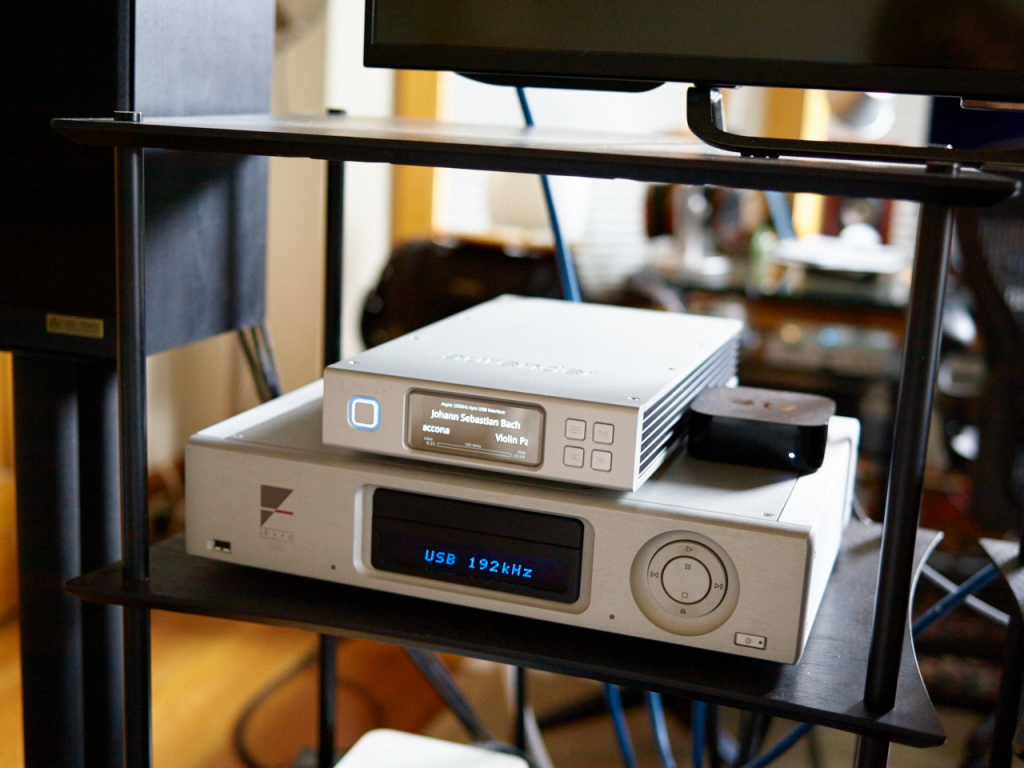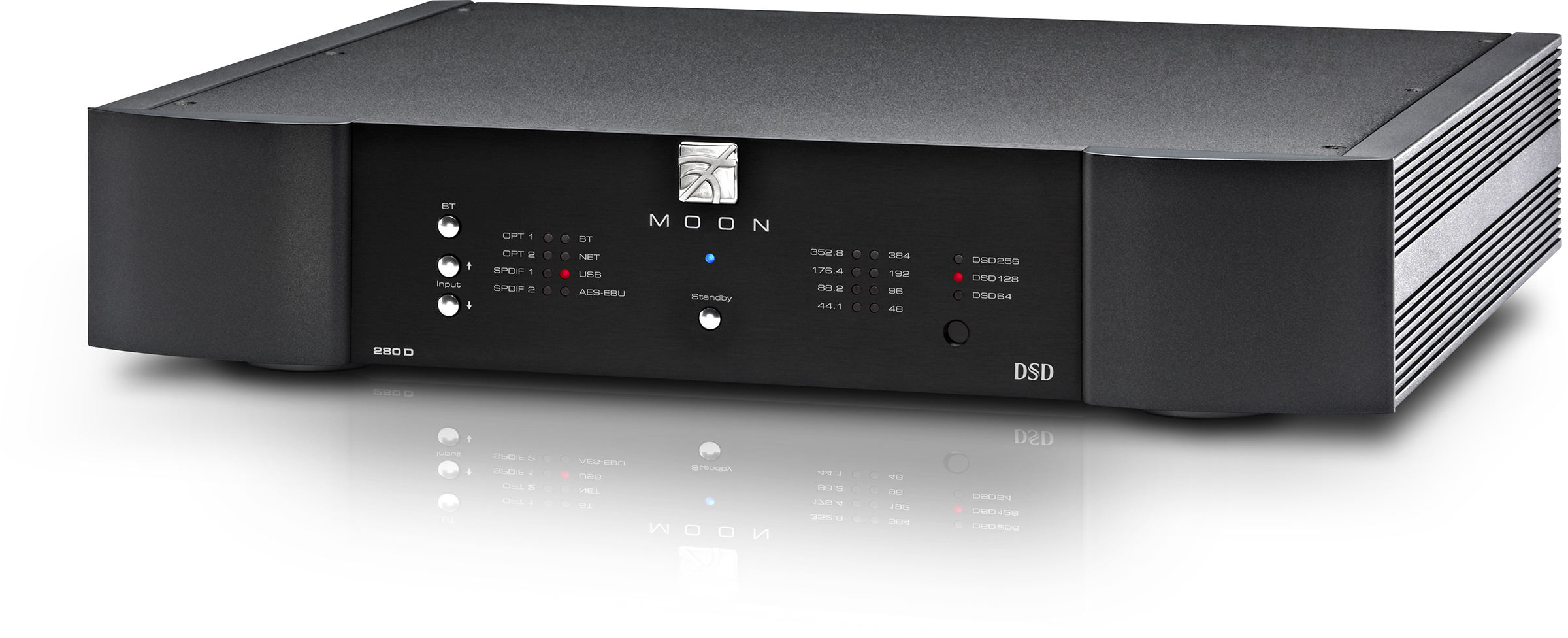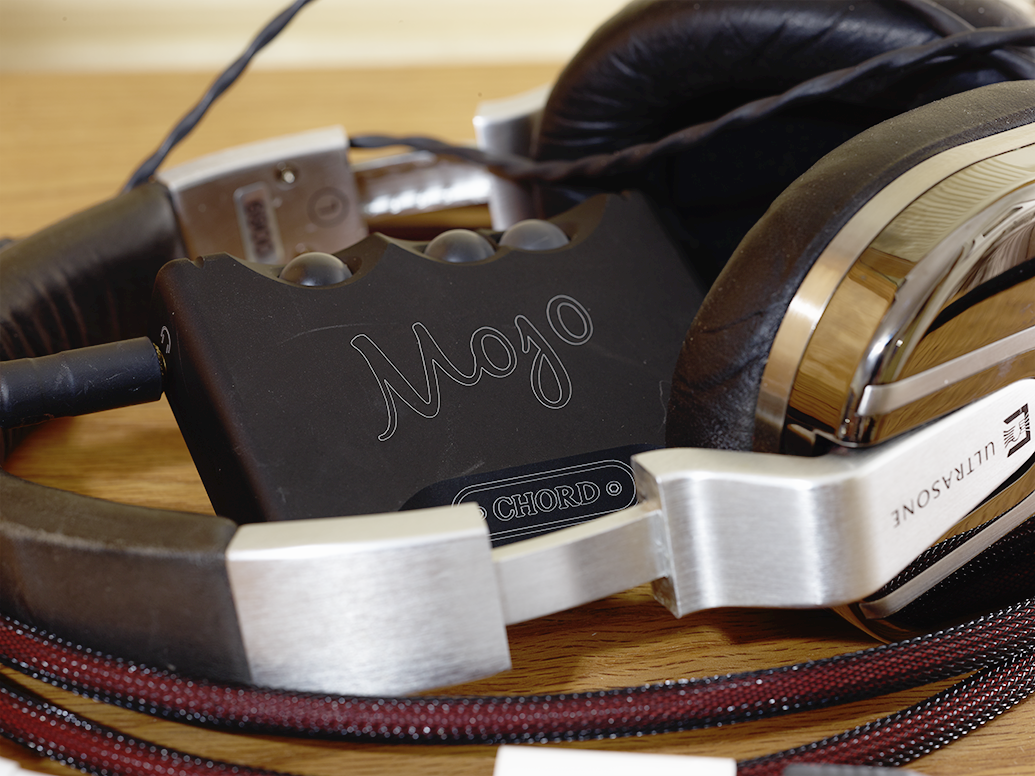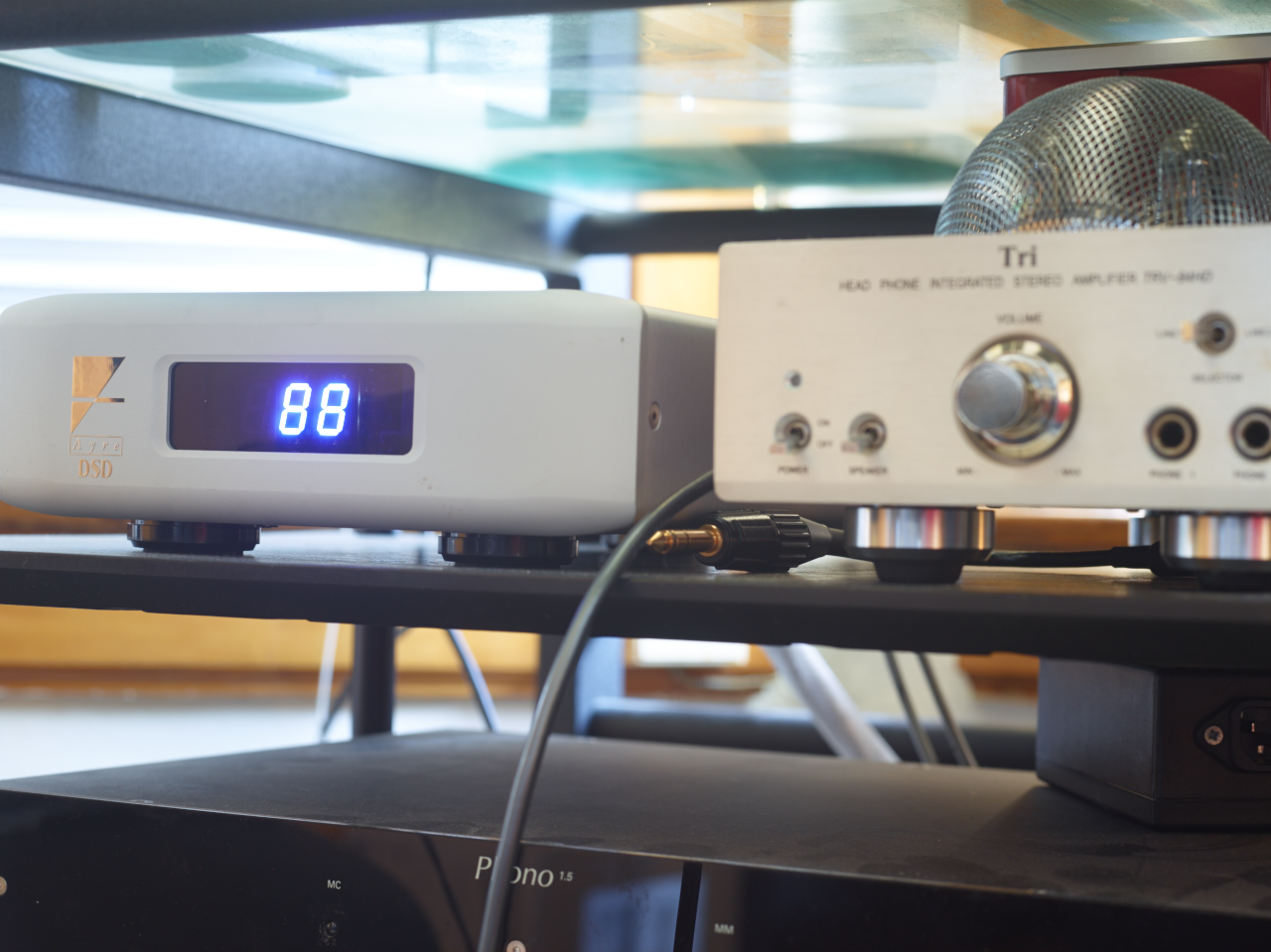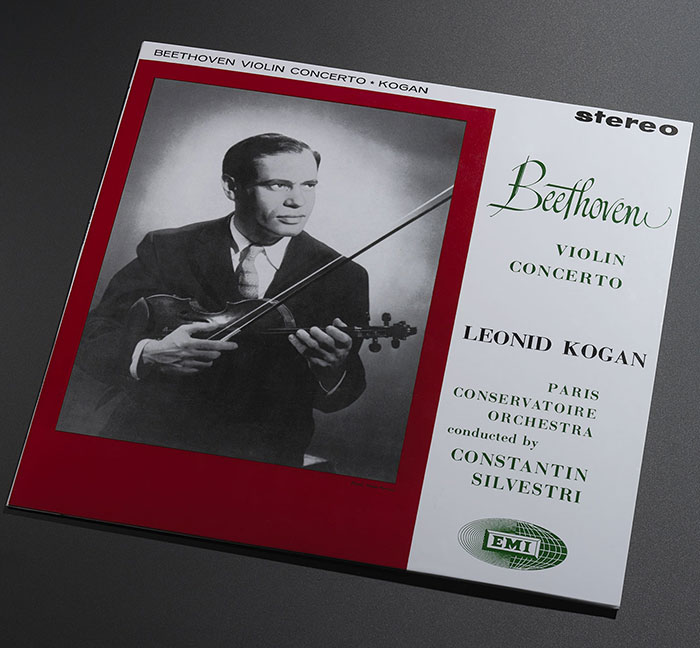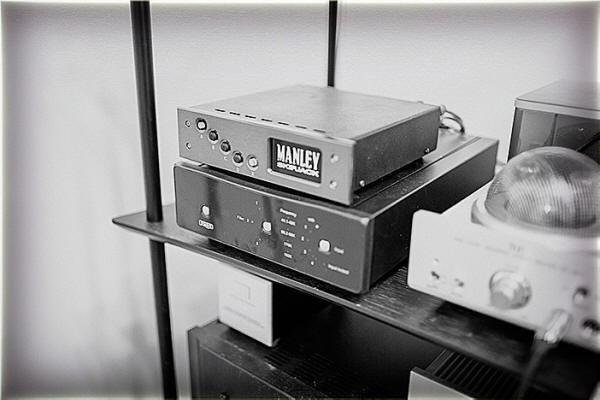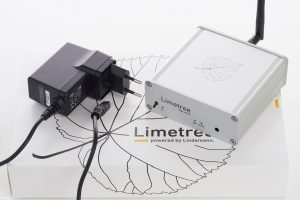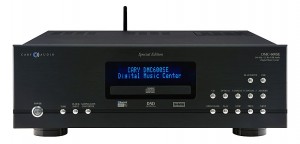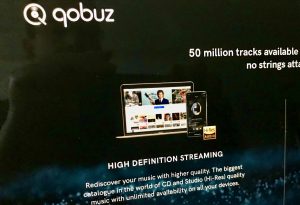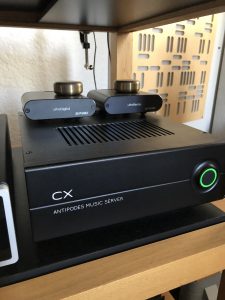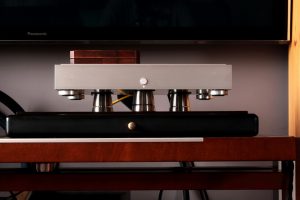"Help!"
—The Beatles
In memory of Lee Weiland, the man who introduced me to the concept of a digital music server and whose Locus Design cables I still use
All my audiophile friends have NAS clusters. There's tremendous peer pressure for me to have one, too, and I tried an inexpensive one to see how I liked it, but I didn't. I don't really need centralized storage in a one-bedroom apartment even though I have three Macs, two iPads, and an iPhone. I prefer that my storage be distributed according to need in an interconnected, peer-to-peer network over gigabit Wi-Fi with lots of backups. In fact, my iMac—where I have most of my data—gets backed up to both a LaCie 6TB RAID drive and a LaCie 4TB "Rugged" drive that I can just grab in an emergency. I have limited cloud storage but will make more use of that as the cost of space goes down. iCloud comes in very handy for sharing current, working documents across multiple devices, but I wouldn't want it to be the source of my music. All this is to explain why I asked Aurender to borrow the N100H rather than the N100, because the H means that I get 2TB of disk space to store my music, copied from my iMac where it gets backed up. I do like streaming TIDAL but it doesn't sound as good as my CD rips and the N100H doesn't play as well with my Ayre QB-9 DSD as it does with other DACs, so I'm using an extremely neutral USB cable, the no-longer-made Locus Design Polestar, while I wait to receive the new entry-level Stealth USB cable on loan. If anyone knows how to make cables, it's Stealth, but I digress …
Apart from improving the relationship between the N100H and my QB-9 DSD sonically, not that the combination sounds bad, I do greatly love the functionality and convenience offered by the N100H and I spent one whole afternoon playing ripped CDs and high-resolution downloads in my secondary system while sitting in my easy chair and controlling what I played with the Aurender Conductor App (which is actually pretty well designed) on my iPad mini. At that point, I was using an old Triode Audio Corporation tube amplifier and a pair of Micropure Kotaro minimonitors with a recently calibrated 12" subwoofer made by Essex in the UK. Normally, though, I play All my ripped CDs and 24-bit downloaded albums on my headphones, either a pair of polished up Audeze LCD-2.2s or a new pair of HiFiMan HE-1000s, both with Moon Audio Silver Dragon cable running balanced from the glorious Cavalli Liquid Gold headphone amplifier, the best headphone amplifier I have ever heard (*). My Ayre QB-9 DSD is hot-rodded directly into the Liquid Gold via a 1.5-meter pair of balanced Stealth Sakra interconnects, which make me want to cry for so many reasons, most of them good ones. The N100H and the QB-9 DSD don't have the depth and three-dimensionality I got from Audirvana Plus running on my iMac, but there are other reasons to love the Aurender and I have yet to test all possible permutations of gear.
(*) Specifically in my main system, with NOS tubes and driving my Silver Dragon Fostex TH-900s, the Woo WA6-SE is every bit as fine an amplifier as the Liquid Gold. It just doesn't have the power to bring out the full potential of planar magnetic headphones such as those by HiFiMan and Audeze. I do have plans for a dedicated review of the Woo WA5-LE, which uses 300Bs (single ended triode tubes) and puts out a good 7-10 watts per channel, all in ultra-pure Class A (much like the solid state but fully differential, i.e., balanced, Cavalli Liquid Gold).
The N100H is a newfangled kind of thing called a media server, essentially a computer in a box without a keyboard or full screen (hence the need for the Conductor App). It's just that N100H looks and feels more like a regular audio component than, say, a Mac mini and has been designed from the ground up to serve music files to a DAC in the case of the N100H by USB only. (The N10 and the W20, each progressively more expensive and by reputation better sounding, offer more ways of connecting to a DAC. Either the N10 or the W20 would be a very appropriate match for my Audio Note DAC 4.1x Balanced Signature in place of the Audio Note CD player that I use as a transport, although I would retain the Audio Note Pallas S/PDIF cable in either case, or possibly use my Stealth Varidig Sextet S/PDIF cable, which does the same thing but sounds not so subtly different).
I have a friend who owns the very famous Pacific Microsonics Model Two reference DAC, which uses something called dual-wire AES/EBU to make the digital connection, just like my old dCS Debussy. The Aurender N10 and W20 will automatically convert DSD files to PCM files if you use a S/PDIF or an AES/EBU connection, neither of which supports DSD. However, all the Aurender media servers simply pass DSD data along through their USB connections and none of them limit the upper sample rate from, say, 24/192 to 24/96 (which would be very useful for me given the 24/96 upper limit of my otherwise splendid Audio Note DAC). Since the firmware running these devices is field-upgradeable, you never know when that function might appear, though, with no need to send anything back to the factory, not that you would have to use new functionality it if you didn't need or want to. As with DSD to PCM conversion, it would likely be controlled through the Conductor App.
In order to be completely fair to the N100H, I am borrowing or buying a couple of other things that will be incorporated into my evaluation of the N100H. They are, in no particular order:
- The New Stealth USB Cable (the most basic one, which you can't "focus")
- The Chord Hugo TT
I'm assuming that with all the gear I already have and these recommended DACs in place, the Aurender will get a full workout. Plus, I can compare the MiND module in the Simaudio 280D to the whole concept of the N100H. The MiND module has its own App and can stream music from a Mac, from an NAS cluster, or from TIDAL (as one example). The only thing it lacks in comparison to the Aurender is its own 2TB of storage. However, I can run the 280D from the N100H via USB. I owe a debt of gratitude to Jeff Roland (not Rowland) at Audio Philosophy LLC (http://www.audphi.com/) for his opinions about the N100H and the 280D, particularly in combination with one another. He's one of the good guys. The same is true of good old Drew Baird at Moon Audio, who recommended the Chord Hugo TT and N100H combination to me.
The first item to arrive was the simple Stealth USB cable, a kind of flat, ribbon-like cable with a cloth sheath. I disconnected the Locus Design Polestar I had been using and inserted the Stealth, then continued to play the 24/192 PCM remastering of Jazz at the Pawnshop I had queued up. I have to confess, I was totally blown away. Everything about the sound improved, including the addition of a sense of richness and depth that I just didn't think the Aurender and Ayre combination had in it. I was ready to throw in the towel and cancel the reviews of the other DACs, but that would be shortsighted and unfair to the other manufacturers. I left my tube amplifier to warm up while I watched an old episode of Mystery Science Theater 3000, but I also wanted to hear the Cavalli Liquid Gold. Later, I turned on my Liquid Gold and listened to a 24/192 PCM download of Bach violin Sonatas and Partitas from Linn, performed by Markku Luolajan-Mikkola. With the Stealth USB cable, their Sakra balanced interconnects, and my Moon Audio Silver Dragon HiFiMan HE-1000s, I felt emotionally engaged in the music in a way that I have only experienced with vinyl in the past.
Oddly enough, someone else described the sound of the Aurender and the Ayre with the Stealth USB cable as, "brittle", however, that was her initial reaction to the Linn recording mentioned above and may have had more to do with the balance between my minimonitors and my subwoofer than the DAC itself. She did say that music played through the Cavalli Liquid Gold and Silver Dragon HE-1000s sounded, "better". All this got me very curious about how the sound of the Simaudio MOON Neo 280D and the Chord Hugo TT would compare, particularly since I felt that the Liquid Gold and the Chord Mojo had a tonally similar quality. I knew for sure that I wanted to keep the Stealth USB cable, because I had never heard my QB-9 DSD sound so deep and so rich, regardless of what other attributes one might attribute to it. I should mention that, around that time, I received an offer to purchase an Audio Note DAC 3.1x/II Balanced DAC, the least expensive Audio Note DAC with a balanced output, and I knew from my experience with my Audio Note DAC 4.1x Balanced Signature in my reference system that I could count, if all else failed, on Audio Note to sound musically correct.
The Chord Hugo TT arrived the day before I got an email saying that the Simaudio was on its way. The Chord spent all day waiting in my hallway while I was resting my sore knee, but around 9:00PM I got the energy to swap the Hugo TT in place, exchange for the QB-9 DSD. I used exactly the same cables. I even got an adapter via Amazon that allowed me to use my Stealth Swift power cable as an extension cable into which I plugged the little wall wart that came with the Chord, just to make sure that things would be as fair and even as possible. I need to make it very clear that this is not a "shootout" between the Ayre and the Chord. I just wanted to know which one would sound best within the context of my system because, within the context of a given system, no two DACs ever sound the same. I was both pleased and displeased to say that the Hugo TT sounded substantially more natural, open, and tonally balanced than the QB-9 DSD again within the context of my system while using the Aurender N100H. I will say that I was under the impression that the N100H had come straight from CES and had many hours on, however I found that it had arrived at my home almost unused, so I created a 200 hour or so playlist and just let it run along with the Chord. My only regret is that, when I sat down to listen to its progress after ten hours or so, a Harry Connick, Jr. Christmas album that came on the Aurender was playing, and I could just not evaluate the sound objectively.
I have a Quadraspire Q4-SVT audio component stand made of bamboo and aluminum in my living room and, eventually, it will have my extra Skipjack on it so that I can run at least a couple of tape decks into the main system through about twenty feet of well-shielded Whiplash Audio Dynamics Sapphire interconnect cables terminated very professionally by a local artisan with Eichmann copper bullet plugs. There was nothing on the stand except for some inkjet paper because my Nakamichi 700 II cassette deck (yes, I said cassette deck) was still being rebuilt. So it occurred that I could put my 11" MacBook Air running El Capitan and Audirvana Plus (not iTunes, just A+ using its own, better-sounding music library manager) and my QB-9 DSD on top of the stand, connect them together via the Locus Design Polestar USB cable I have mentioned, and plug them both into a long, gray, three-prong extension cable just for now, with my very last remaining Locus Design Keynote AC power cord connecting the QB-9 DSD to the extension cable.
I could then play, say, the 24/192 PCM download of Jazz at the Pawnshop through my main system and really test the mettle of the Ayre DAC in this most basic, Aurender-less configuration. You know what? It sounded stunning, and not because I had it going into my Audio Note Oto Phono SE Signature integrated amplifier, because I did most of my listening through my Woo Audio WA6-SE headphone amplifier (with NOS tubes) and twenty feet of Moon Audio Silver Dragon V3 headphone cable soldered directly to the voice coils of my Fostex TH-900 headphones. I could even control everything from my iPad via the A+ remote control App. It made me wonder, despite my initial and overwhelming enthusiasm towards the Aurender, about the necessity of have a dedicated media server as a physically separate box. The idea of having a bit-perfect data stream running from the hard drives in the N100H using a proprietary operating system—because the Aurender is really just a computer in a box with no keyboard, mouse, or full screen—seemed very appealing to me particularly given the elegance of the Aurender Conductor App user interface. However, the user interface for the A+ remote App seemed very well designed, too, and I really dug the sound that using the A+ library manager gave me, an option quite unavailable on the Aurender (and somewhat antithetical to its purpose).
After a couple of days of continuous play, I heated up the Cavalli Liquid Gold and donned my balanced, Silver Dragon V3 HiFiMan HE-1000s only to discover that, much to my disappointment, the sound of the N100H seemed to be shifting in the wrong direction. Instead of getting warmer and more liquid, it sounded even more astringent and hollow than it had when I first connected it to the Ayre QB-9 DSD with the AudioQuest Diamond USB cable. I have to confess that this upset me because I really wanted the N100H to sound "right" because I really liked the idea of a standalone media server driving the DAC of my choice. I felt relatively sure that the fault did not originate with the Chord Hugo TT. However, both devices were new to me. The QB-9 DSD went through some odd changes in its sound during its first 200-300 hours and I was still playing files that I had not loaded onto the N100H, although at least the album appeared to be a CD rip of a Elton John's Madman Across the Water, an album that I really like and that reminded me of my first girlfriend, particularly the song, "Tiny Dancer". Still, I could just not engage in the music particularly after hearing the awesome combination of my 11" MacBook Air and QB-9 DSD governed by Audirvana Plus. So maybe a little DSP (Digital Signal Processing) went a long way, and/or maybe the A+ library manager just did a really great job of pulling the real bits off of the Fusion drive in my iMac. Maybe a bit-perfect data stream wasn't the best real-world option? Maybe new Coca-Cola had tasted better? It was all just too soon to tell.
Rather than wait around for the rest of the 200 or so hours of the N100H to complete, I decided to take a pause and connect the Hugo TT directly to my iMac, running El Capitan and A+, via my original three-meter AudioQuest Diamond USB cable. I could always add more hours to the Aurender later, right? After spending the better part of an hour trying different USB ports, reviewing various articles on the web, including one from Chord, and confirming that my iMac hardware could physically see the Hugo TT, I had to come the conclusion that the Hugo TT would not work with the latest version of El Capitan (10.11.3), at least not with my iMac using any USB connection on my iMac and my trusty old AudioQuest Diamond USB cable, with Chord attributing this to a "bug" in the latest version of El Capitan and suggesting that one roll back to Yosemite (are they for real?). So until my two-meter WireWord Supernova 7 Mini glass TOSLINK cables arrives or Apple updates El Capitan again, I could only run the Hugo TT with the N100H within the context of my desktop system, which—put in technical jargon—totally sucks. I was beginning to have my doubts about both the N100H and the Hugo TT and I left them both powered down for the rest of the night, because it was already 4:17AM and I needed to get some sleep.
I confirmed the next day that Apple's change to El Capitan (I will not call it a "bug", a greatly misused term, without more evidence) caused a number of DACs to stop connecting to OS X via USB, so while I waited for my TOSLINK Mini cable to arrive, I moved the N100H to the USB input of my Ayre DX-5 DSD in my two-channel home theater system, still using the entry-level Stealth USB cable, and continued breaking in the Aurender. I did take a quick listen to Elton John via the analog output of the DX-5 DSD going through my Tri TRV-84HD tube triode headphone amplifier into a pair of Silver Dragon V3 Beyerdynamic T5p headphones (an overall more forgiving combination than I had used before), and still found the N100H to sound excessively bright. However, I was hardly near the 200 hour threshold I had been given, so I decided just to wait before making any final judgements, eagerly anticipating how the Chord Hugo TT would sound with Audirvana Plus on my iMac. I think the thing that disappointed me the most about the Chord is that it came with a wall wart style power supply, because, even though it ran off of batteries combined with super capacitors for transient peaks, there's just no excuse for excluding a good linear PSU with a DAC that costs $5000. However, as I mentioned, I had converted a Stealth Swift power cord to a potentially filtering extension cable, so at least I didn't lose any territory on the back of my Equi=Tech by virtue of Chord's clumsy plastic power supply.
I'm now listening to the 24/96 download of Siwan by Jon Balke, et al, from hdtracks.com and it sounds lovely through the Hugo Chord TT even though Audirvana Plus is downsampling it to 24/48 to accommodate the "SD" USB input of the Chord, given that the "HD" USB input (which is what goes up to double-DSD) will not work with El Capitan 10.11.3 specifically on my iMac (and on others from what I have read) most likely because of a design change on Apple's part that did not account for backwards compatibility. However, it really does sound lovely, and I am very happy.
That has nothing to do with the Aurender, however, which had made its way into my two-channel home theater system and has many hours on it. It went through a period of brightness followed by a period of silkiness followed by its current state of richness and depth. So, again, I am happy. I have not done a serious evaluation with high-resolution files as most of its contents are CD rips, but that will come shortly. To explain, my two-channel home theater is in a state of flux to improve its sound quality, but the signal is traveling along a chain in the following order at the moment:
- Aurender N100H
- Stealth USB Cable
- Ayre DX-5 DSD Universal A/V Engine
- Audio Note AN-Vx Interconnects with Eichmann Silver Bullet Plugs
- Arcam AVR450 Audio Visual Receiver (two-channel analog input)
- Custom-made Bi-wire Audio Note Lexus Speaker Cables
- Modified Audio Note AX-Two Bookshelf Monitors
The power cables are made by Stealth and Audience and are connected to an extra beefy Equi=Tech balanced transformer in turn connected to a PS Audio Power Plant 10, because the power in my home is really sucky. The whole thing is sitting on a side-by-side pair of Quadraspire Q4-EVO component stands with a Sony 43" 4K HDTV on top.
Replacing my Blu-ray player with the DX-5 DSD, my cables with the Audio Notes, and my speakers with the modified AX-Twos has made home theater much more engaging with a much gentler and more open sound quality even when the screen is completely blank, not to mention a much improved image quality when I am watching a DVD or Blu-ray Disc through Transparent High Performance HDMI cables (the blue ones). Plus, I can play SACDs.
The very long playlist that I created for the N100H completed and, sure enough, the Aurender had started to sound very rich, warm, and musically engaging. So now all I had to do was to return to my reference album, the 24/192 PCM download of Jazz at the Pawnshop that I got from HDtracks.com. Because I decided to listen late at night, and to hear more detail, I ran the DX-5 DSD into my original Triode Audio Corporation TRV-84HD (not the Mk. II) through a pair of Audio Note AN-Vx interconnects with Eichmann Silver Bullet Plugs. I connected a pair of Silver Dragon Beyerdynamic T5ps, which I think need some repair but are still very functional, terminated with a Furutech FP-704 (G) 1/4" stereo phone plug, my personal reference phone plug, to the TRV-84HD, which can easily drive the sensitive, 32 Ohm headphones even with a maximum output of only 500 milliwatts through one of its two headphone sockets.
I think I may have had the volume turned up a little bit too high because sometimes the percussion hurt my ears, but there was no actual fault with the sound. I heard a wide, deep soundstage with proper image placement and a liquid midrange giving way to a detailed but defined and gentle treble. Did this sound as good as the Cavalli Liquid Gold with the HiFiMan HE-1000s? I don't know, maybe. The tenor sax certainly sounded very natural to me and I could tell it was a tenor sax (while still hearing water glasses clinking in the background). I felt happy, and that's all I ever ask of music, to be moved emotionally. Whatever changes the N100H had gone through during its initial run in had worked and now, with the Stealth USB cable and the USB input of the DX-DSD, which already had many hours on it, the combination easily equaled or exceeded the sound of Audirvana Plus running on my iMac, and that was all I had ever asked. So I lay in bed with my headphones on and my iPad Air 2 in my hands and listened the night away. The N100H, the Stealth USB cable, and the Chord Hugo TT, each in its own place, were all keepers.
Kindest regards,
Andy
Epilog
I should mention that I've been running iTunes on a continuous loop into the Chord Hugo TT for several days now, and that the DAC has started to develop a much more "mellow" sound quality while still sounding open. I also replaced the Silver Dragon headphone cable I was using with my HiFiMan HE-1000s with the softer-sounding Black Dragon cable, something that further controlled the high frequencies coming out of my Cavalli Liquid Gold and struck just the right tonal balance. All that being said, I still prefer using the Aurender N100H with the Stealth USB cable and my Ayre DX-5 DSD in my home theater system, mostly because of the sound quality of the Audio Note AX-Two loudspeakers. I also have the preamplifier output of my Arcam AVR450 going into a Tri TRV-84HD headphone amp, driving a pair of Silver Dragon Beyerdynamic T5p's. The Aurender just seems like a more natural fit in that system perhaps because of the overall more detailed but gentle sound quality of the system itself. Now I'm off to evaluate a Simaudio MOON Neo 280D with its MiND network module, all connected to the main system ...




